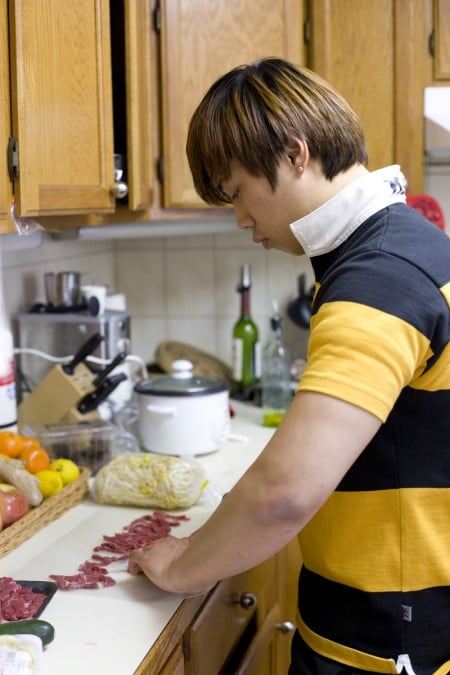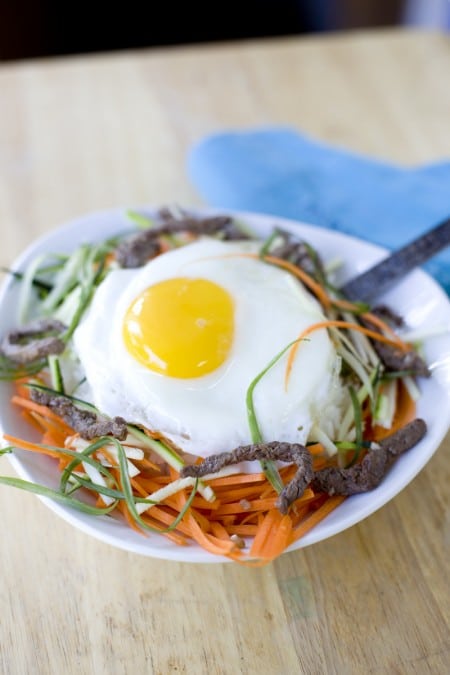
Bibimbap, Bibimbap! I just love saying it! Go ahead, try it out. Say it Bee Bim Bop. Isn’t it fun? But more than fun to say, bibimbap is fun to eat, and even good for you! It’s a signature Korean dish consisting of rice, an egg and various vegetables, and often made with beef. It’s so popular in Korea that it even has its own museum! The great thing about this Korean recipe is that you probably have most of the ingredients already. The only one that may be new to you is gochujang (or kochujang), a spicy chili paste.
Korean cuisine is very in your face. It’s characterized by smoky flavorful meat, bright fresh vegetables and fiery hot peppers. Bibimbap is no exception, though the execution may differ from one cook to another.
The one consistency to all bibimbap recipes is that it’s a complete meal. You get your starch, protein and vegetables all in one bowl! But the rules stop there, and even that isn’t a rule. Sometimes it’s served with just rice and an egg in the bowl and all the vegetables, meat and sauces are in separate bowls for people to take what they’d like to add to their bowl. Sometimes, the egg isn’t even fried, just a raw egg poured over the hot rice to cook slightly from the heat in the bowl.
According to clickkorea.org, the first ever mention of bibimbap is in Siuijeonseo, a cookbook compiled in the late 1800s. The ClickKorea article is worth a read, listing four different theories for how bibimbap came to be. My personal favorite is the ‘Donghak uprising theory.’ They say “When the Donghak uprising (a revolutionary movement led by peasants to protest the rampant corruption of government officials and the encroachment of foreign powers) broke out in the Gobu area of the Jeolla provinces in 1894, the Donghak peasant rebels were forced to mix their rice together with side dishes because of their lack of bowls and plates.” I love the idea of this delicious dish being born out of necessity by the underdogs fighting for their rights.

Our exchange student from Korea, who goes by his American name Eric which has led to me calling my husband “Babe” 90% of the time, was excited to teach me how his mom makes bibimbap. I eagerly took notes and asked questions through every step. He wanted to make sure I knew that there’s no set formula, you can really do whatever you want for bibimbap.
It’s a dish that’s meant to help use up leftovers. When you have small bits of meat, a few vegetables, scraps of food, they can all go into your bowl.
We didn’t make ours from leftovers though, we bought a month’s worth of groceries that day so everything was fresh. Here are the details on how we made our bibimbap.
Beef: You want very thinly sliced steak cut into strips for your bibimbap. We get our steak from a farm, but we did buy some for this recipe because we didn’t have any thawed. If you are buying steak in the grocery store, use a cheap cut. In this recipe it’s sliced so thinly that you won’t notice if it’s a little tough. I rarely buy meat pre-sliced, I just put the steak in the freezer for 15 minutes to make it easy to slice. But at the Korean grocery store, pre-sliced ingredients (meat, vegetables, fish, etc) cost the same per pound so we went the easy route.
Vegetables: You can seriously use any vegetable. They just need to be thinly sliced. For long vegetables like carrots, zucchini or cucumber, I recommend a julienne peeler. Eric was pretty impressed with how fast it made the chopping go! It’s a dream kitchen tool come true. You can slice mushrooms, broccoli, cauliflower or peppers into small pieces to add. You can also use various greens; baby spinach, watercress, parsley, kale, bok choy, green onions. Bean sprouts are also a very popular addition. We left all the vegetables raw, except the sprouts which I steamed very slightly (forgot to add them for the pictures though!). I really liked the contrast of crunchy vegetables with the soft rice and chewy beef.

Egg: As I mentioned above, you can break a raw egg over your hot rice as the base of the dish. I might try that one day with an egg fresh from the farm, but until then I’m sticking with a fried egg. They’re simple to make. I wipe out my skillet with a paper towel after cooking the beef and then fry the egg in what little oil still coats the pan. Just heat it on medium high and break an egg into the pan. Let it cook 3-5 minutes until it’s solid enough to pick up with a spatula. You don’t want to overcook it because the yolk should be runny. Once your bowl is filled, everything gets mixed together and the runny yolk mixes into the whole dish.
Gochujang: This spicy sauce is for Korean food what ketchup is for American food, it’s good on anything and everything! I’ve seen it spelled with both a K and a G, so look for either. It’s a dark red paste with a rich and spicy flavor. Typically it’s made with fermented soy, glutinous rice powder, chili powder and salt. It sometimes contains a sweetener as well. Gochujang is ridiculously expensive on Amazon. It was only $3 at the Korean market. If you don’t have an Asian market near you, I recommend buying it Hmart.com instead. While traditionally it is gluten free, it often contains barley now, so if you need a gluten free sauce I recommend using sriracha or, even better, making your own gluten free gochujang.
Sesame Oil: Sesame oil is a vegetable oil made from sesame seeds. It’s very popular in Korean cuisine for it’s spicy quality, it’s not spicy like a pepper but does have a bit of a bite to it. Sesame is one of the first crops to ever be pressed for oil. There are a variety of colors for sesame oil, pale yellow is a cold pressed sesame oil, the dark brown oil typically used in East Asian cooking is from toasting the seeds before pressing and has a stronger flavor. I always buy the dark brown because when I’m using it I want the flavor to shine through. You can get this in your regular grocery store but I can buy it by the gallon at an Asian grocery store for the same cost as a small bottle at my local grocery stores.
Alright, are you sold? Don’t you want to run to the fridge right now to see if you can make this? Oh and by the way, just like my Vietnamese Steak Sandwich, this is a great starter recipe for getting the man in your life to like Asian food.

Easy Korean Recipe: Bibimbap

Ingredients
- 1/2 lb flank steak, sliced matchstick size
- 2 TBS soy sauce
- a pinch fresh ground pepper
- 6 cloves garlic, minced
- 2 TBS sesame oil
- 1 cup bean sprouts
- 6 cups cooked rice
- 4 eggs, fried
- 2 carrots, julienned
- 1 zucchini, julienned
- to taste gochujang, sesame oil, soy sauce
Instructions
- In a small bowl, mix together the steak, soy sauce, pepper and garlic. Heat the sesame oil in a skillet on high.
- Place bean sprouts in a steamer basket in a pot with a little water. Heat on high, cover and steam 2 minutes, then remove from heat.
- When sesame oil is beginning to smoke, add meat and stir quickly until it’s all browned, 3-4 minutes.
Place up to two cups of cooked rice in each bowl and top with a fried egg. Sprinkle carrots, zucchini, bean sprouts and beef around the egg. - Let each person top their bibimbap with gochujang, sesame oil and soy sauce as desired. Use a spoon to mix it all together and eat it.
Notes
Approximate cost/serving: If you use cheap vegetables, this is a pretty affordable dish, especially because there is very little steak. It will be even cheaper when I’ve grown my own vegetables! This came out to $8 with everything from the Asian grocery store, including the rice. It served 4 of us, but these were HUGE servings and our boys ate double what we did. Still, we’ll call it $2 a serving for a complete meal.
Vegetarian/Gluten Free: You can definitely skip the meat and make a vegetarian version, though it wouldn’t be bibimbap without the egg. For gluten free, use sriracha in place of gochujang or make your own. Make sure your soy sauce is gluten free as well.
Nutrition Information:
Yield:
4Serving Size:
1Amount Per Serving: Calories: 647Total Fat: 23gSaturated Fat: 6gTrans Fat: 0gUnsaturated Fat: 15gCholesterol: 229mgSodium: 1030mgCarbohydrates: 77gFiber: 3gSugar: 5gProtein: 31g
Nutrition information is an estimate only.

I am already totally sold. I have no idea if it’s remotely authentic, but when I would get it in Boston we had the option of having it served in a normal bowl or a hot one. I’d be curious if that really exists in Korea or if it’s just some American invention. It was lovely though because it lead to some really crispy, crusty rice on the bottom which sounds awful, but was really delicious.
Glad you’re having a fun time with your exchange student and learning to make some authentic dishes in the process; how fun!
It really exists! Dolsot bibimbap is served in a hot bowl. The inside of the bowl is typically coated in some sesame oil to get the rice touching it nice and crispy. A raw egg is more common with the dolsot bibimbap because everything is so hot that the egg cooks quickly as it’s mixed in.
The crispy rice is called nurungji and is so popular in Korea that it’s been turned into a packaged food! It’s not just in dolsot bibimbap, it’s always saved from the rice pot to eat as a snack or used as a remedy for upset tummies. It’s often turned into other traditional dishes such a porridge, and I’ve heard lately it’s even been used to make pizza!
I love bibimbap! You don’t even need a recipe for it. Bibimbap is one of my go-to meals since it’s so easy. I like to cut up a bunch of veggies and other ingredients ahead of time and store them in the fridge. My roommate and I almost always have rice around, so all I have to do is fry up the veggies and protein and mix it with rice.
I also suggest adding cut-up strips of seaweed and sesame seeds (but I imagine if you have sesame oil, you don’t need the sesame seeds).
It’s so true, you really don’t need a recipe. But there are some people who panic without one. I love it with strips of seaweed and sesame seeds sound great too.
I was just about to write a recipe for bibimbap, but this was probably better than I could have offered! Thanks!
Thanks so much, that’s quite a compliment for this haole (white) girl!
Hey, I learned something new, I always thought there was sesame (or maybe peanut) in the actual sauce. This looks awesome, what a sweetheart your student sounds like.
Yeah, love having exchange students. He taught me bibimbap, I help him with his essays. It works out well!
That looks great and I always love getting recipes directly from the source! I used to eat bibimbap all the time in Japan—they adore Korean food there and I still can’t get enough kimchi into my system. I crave it all the time! I was in Seoul many moons ago and devoured everything I could find there. The bibimbap I had in Japan was made from ground beef, not strips of beef, but maybe that’s a regional difference from within Korea, or maybe that’s just how the Japanese interpret it. I also love the way they cook it in those hot bowls and the rice gets so crunchy on the outside! I must admit I do love the raw egg that cooks in it, too.